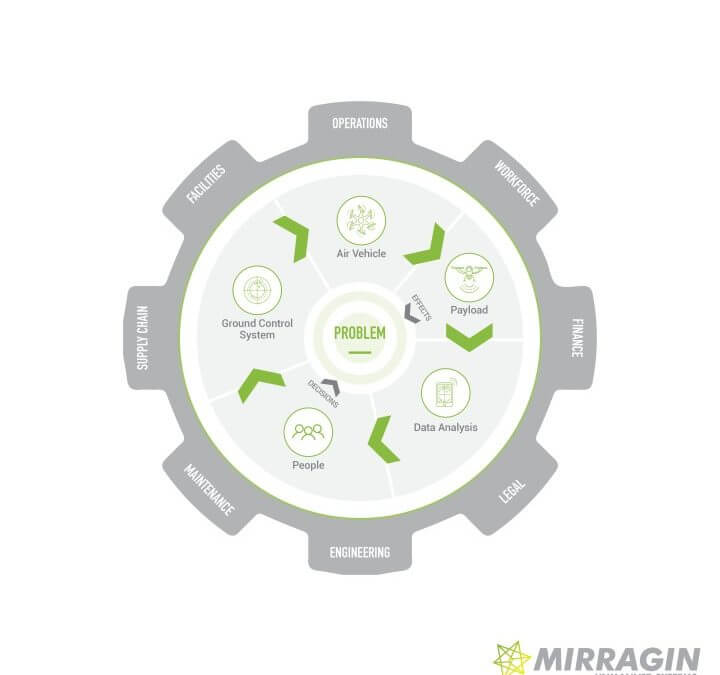Drones have a staggering number of applications but in recent years, the use of drones has revolutionised everything from emergency response to hobby photography.
As drones become more powerful, more capable and more commonly used across all industries, organisation are starting to consider the finer details of implementing an effective drone program.
Defining the problem
Organisations use drones to solve problems. Maybe you need to save manpower by deploying drones to take care of tasks that people normally perform, or maybe you’ve identified that drones provide a more cost-effective approach to an issue your business is currently tackling with different tools.
No matter what the issue is, the problem has to be defined before you can design a solution. Once the problem is defined, you need to ask yourself if the drone is the right tool for reaching the solution. If you pick the wrong tool for the job, it’s possible the project will fail and result in lost time, lost money and lost opportunity for your organisation. That’s why it’s crucial to understand the problem from the start.
Understand the physical system
Once you know the problem that needs solving, you can start thinking about all the necessary pieces. A comprehensive drone solution involves much more than just an unmanned air vehicle. Consider each of the following components of the physical system:
● The air vehicle: drones come in many types with different specifications and abilities. The drone you ultimately choose for solving the problem varies on your needs, budget, preferences and other factors
● The payload: the payload is the equipment the air vehicle carries to perform its duties. This refers to components that people often fail to think of as separate from the vehicle itself, like cameras, radar, lasers, sensors, communications technology and more.
● The ground control station: this refers to the area where the drone pilot flies the drone. It might be as simple as a spot on the ground where the pilot stands with the control stick, or it may be an elaborate facility dedicated to drone flight.
● Data analysis: drones are perfectly suited for gathering data, but that data is only useful if you have effective ways to process and present it. You may also need to consider regulations and bandwidth limitations in regards to data analysis.
● People: no matter what your drone program looks like, you’ll have a remote pilot (the person who operates the drone), a data analyst (the person tasked with processing and analysing data gathered from drone operations) and a decision maker (the person who oversees the drone program and works to achieve the overall goal)
The physical system is much more than just the drone, even in small-scale operations. Each of the above pieces has to work in tandem seamlessly to achieve the solution you’ve designed in response to the problem.
Consider the enabling system
Outside of the physical components needed to implement a drone program, there are also non-physical pieces that must be carefully considered as part of your overall strategy. The enabling system has eight key pieces:
● Operations: this refers to all the pieces that allow your drone program to run smoothly, including flying and safety management systems, standard operating procedures, emergency procedures and other systems and policies that impact drone use.
● Workforce: drones are rapidly changing and evolving, and your drone program won’t remain effective if personnel aren’t trained and up-to-date on the latest technology. Everyone from remote pilots to upper management needs to be part of your drone operations.
● Finance: finance doesn’t only cover the costs of implementing your drone program – it also includes contingencies. What will you do if an accident happens and your payload is damaged, or if your company is exposed to liability because of drone use? These are just a couple of questions to consider as you think about the finances behind a drone program.
● Legal: there are local and national laws impacting drone use that can’t be ignored. Knowing the ins and outs of key pieces of legislation, like CASA Part 101 and the Work Health and Safety Act of 2011, is crucial for drone operations.
● Engineering: your drones must be safe, environmentally compliant and up to the tasks they need to perform. Engineers can help ensure that all of these requirements are met.
● Maintenance: like any machine, drones have to be repaired, maintained and inspected – an ongoing maintenance program is a necessity.
● Supply chain: from contract management to sourcing spare parts, the supply chain needs to be thoroughly examined to make sure your drone program is sustainable and won’t hit bottlenecks.
● Facilities: the larger your drone fleet, the more space you’ll need for maintenance and care. Think about the size of your drone program and consider the impact of the size on new or existing facilities.
Together, the physical and enabling systems form the basis of your drone program, and allow you to address the problems your organisation hopes to solve through drone use.
Drone programs involve many moving parts that must work together in perfect order. If you would like help with implementing an effective drone program, or with troubleshooting an existing program, you can book a consultation with us at admin@mirragin.com.au.

